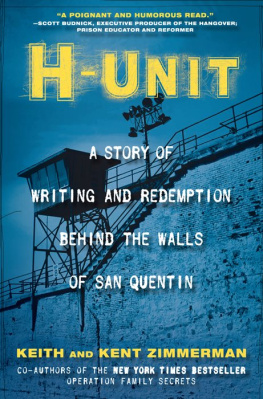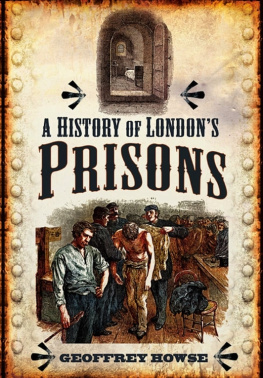

This edition is published by Muriwai Books www.pp-publishing.com
To join our mailing list for new titles or for issues with our books muriwaibooks@gmail.com
Or on Facebook
Text originally published in 1961 under the same title.
Muriwai Books 2018, all rights reserved. No part of this publication may be reproduced, stored in a retrieval system or transmitted by any means, electrical, mechanical or otherwise without the written permission of the copyright holder.
Publishers Note
Although in most cases we have retained the Authors original spelling and grammar to authentically reproduce the work of the Author and the original intent of such material, some additional notes and clarifications have been added for the modern readers benefit.
We have also made every effort to include all maps and illustrations of the original edition the limitations of formatting do not allow of including larger maps, we will upload as many of these maps as possible.
CHRONICLES OF SAN QUENTIN
THE BIOGRAPHY OF A PRISON
BY
KENNETH LAMOTT
TABLE OF CONTENTS
Contents
ACKNOWLEDGEMENT
Most of the original research for this book was done by my wife, Dorothy (Nikki) Wyles Lamott, who brought to the job her experience as a researcher and reporter. Whatever merits this book may have as history are largely her work. The shortcomings, of course, are mine alone.
ILLUSTRATIONS
San Quentin, 1859
The First Great Fire, 1876
Stripes, 1871
The Prison, 1893
San Quentin Village
Sunday Visitors, 1915
The Porch, around 1900
Womens Quarters, around 1905
TB Ward, 1921
The Canteen
W. H. T. Durant
Dr. A. W. Taliaferro
Warden John E. Hoyle
Ralph H. New, George Mantlo, Clinton Duffy, and Julian Alco
Dr. Leo L. Stanley
Warden Fred R. Dickson
Loom Row
Sack Alley
Road Camp, about 1916
The War Effort
The Ball Club
Field Day, 1921
Sarah Bernhardt Visiting San Quentin
Professor Gallur and His Band, 1921
The Big Show, New Years Day
A Door in the Stones
A Modern Cell
Siberia
Condemned Row, Old and New, about 1940
The Gallows
The Gas Chamber
The Big Yard and the Unemployed, 1958
The Garden Beautiful, about 1930
Mess Hall, Old Style
Mess Hall, New Style
East Block
Chapter IWABAU
ON a bright, warm Monday in May, 1960, a stooped and rather heavy-featured thirty-eight-year-old man named Caryl Chessman sat down in chair B in the small steel room in San Quentin prison where the state of California executes its condemned criminals. While two guards rapidly strapped down Chessmans arms and legs, other guards kept wary eyes on the sixty reporters and official witnesses, as if they expected a demonstration in favor of the prisoner.
Chessman turned to one of the sea-green windows and spoke to the reporters outside. Tell Rosalie I said good-by, he said. (Rosalie Asher was one of his lawyers.) Then he added, Its all right. A woman reporter made a circle of her thumb and fore-finger, and Chessman smiled slightly.
At 10:03 the executioner pulled the cherry-red lever that dropped a bag of cyanide pellets into the tank of acid. Chessman breathed deeply for twenty seconds, then he raised his eyes to the ceiling, and his mouth fell open. At 10:05 he coughed. A minute later his face broke out with sweat and saliva dribbled from his mouth. He fell forward, his body straining against the straps; he cried, and his body heaved. At 10:12 he was pronounced dead by a prison medical officer, who had been listening to Chessmans heartbeat through a long stethoscope tube that passed through the wall of the gas chamber. The doctor estimated that Chessman had been conscious for only thirty seconds of the nine minutes it had taken him to die.
Although the warden of San Quentin said afterward that there had been nothing unusual about the execution, and although he was technically correct. Chessmans long-drawn-out march from courtroom to gas chamber had been one of the most extraordinary and curious affairs in the social history of our times. Somehow, the condemned mans shrewd and stubborn fight to stay alive had struck a sensitive nerve and provoked a worldwide reaction that was hard to account for merely on the merits of his case.
The Chessman case is still fresh in our minds, but it is only the most recent of the many occasions on which San Quentin has acted as a mirror to the contradictions and ambiguities that are usually hidden under our conventional attitudes toward crime and punishment. From its haphazard founding in the days of the Gold Rush, the great prison on the shore of San Francisco Bay has faithfully reflected the curious combination of guilt, vengefulness, and prurient fascination that has been the dominant theme in our treatment of our criminals. Both for this reason and for its own gaudy history, which contains full measures of violence, brutality, greed, sex, alcohol, and corruption, San Quentin has fairly earned its position of eminence among the walled prisons of the world.
The history of San Quentin prison properly begins in 1849 with the great migration of adventurers to the banks of the Sacramento, the Feather, the Yuba, the American, the Cosumnes, and the Mokelumne. Although American settlers had arrived in California long before gold was discovered early in 1848, the great invasion of miners did not begin until the steamer California dropped anchor in San Francisco Bay on the last day of February, 1849. During the remaining months of 1849, some fifty thousand vigorous and aggressive young men streamed into northern California. Besides the North Americans there were thousands of Spanish-speaking Central and South Americans, French, and Germansmany of them escaping the aftermath of the political upheavals of 1848and a sizable contingent of Australians, who in many cases came all but directly from the convict hulks of Botany Bay and Van Diemens Land.
During the first six months of 1850 the population of San Francisco was increased by two thousand women from New York, New Orleans, and the sinful cities of Europe. They were the vanguard of an invasion of young women few of whom were of notable chastity. Although some are said to have devoted themselves to such useful pursuits as washing clothes, keeping house, and raising children, the vast majority abandoned themselves to every conceivable variety of dissipation and bawdiness, creating a social milieu which has been vigorously described in Herbert Asburys classic The Barbary Coast . The prevailing moral atmosphere of the 1850s has been preserved in the ditty which begins:
The miners came in forty-nine,
The whores in fifty-one;
And when they got together
They produced the native son.
As the city spread out from Portsmouth Square over the surrounding hills, the districts that remained to the poor, the unfortunate, and the wicked became clearly defined. The pioneer whores, sluttish and unlettered females from Mexico, Chile, Peru, and other countries of Spanish America, congregated in rough shanties in the neighborhood of Clarks Point and up the adjoining slopes of Telegraph Hill, while a Little Chile of other Spanish-American outcasts sprang up north of Washington Street. On upper Broadway and Pacific streets were found the grogshops and sporting houses of the escaped convicts and ticket-of-leave men from Australia and Tasmania. Here in Sydney Town drinks were drugged, throats were cut, and women had sexual congress not only with drunken miners but also, for the instruction of the curious, with such partners as boars and Shetland ponies.
Next page










